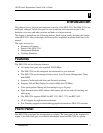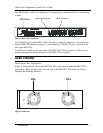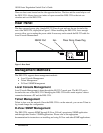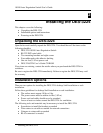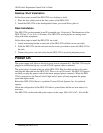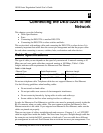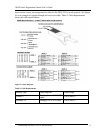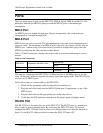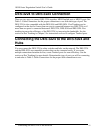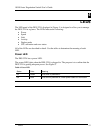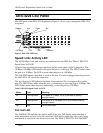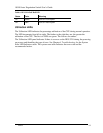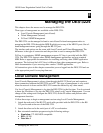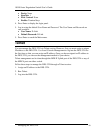
10/100 Auto Negotiation Switch User’s Guide
Connecting the DES-3224 to the Network
10
Ports
There are three types of ports on the DES-3224: MDI-II Uplink, MDI-X and RS-232. The
difference between the MDI-II Uplink port and the MDI-X ports is the internal pin
arrangement.
MDI-II Port
An MDI-II port is a straight through port. The pin arrangement is the same as the pin
arrangement of a straight through cable.
MDI-X Port
MDI-X ports are crossover ports. The pin arrangement is the same as the arrangement in a
crossover cable. The advantage of an MDI-X port is that you can connect a device with an
MDI-II port without using a crossover cable. Just make a straight cable, plug it into the
MDI-II port and plug the other end into another device.
Table 3: Cable Connections, displays the proper cable to use when connecting to various
devices.
Table 3: Cable Connections
Other device
DES-3224 Workstation with MDI-II Port
MDI-X MDI
MDI-II Crossover Straight Crossover
MDI-X Straight Crossover Straight
The steps for connecting the DES-3224 to 10 Mbps devices or 100 Mbps devices are the
same. All the ports will auto negotiate the proper speed and duplex mode. The DES-3224 has
two rows of 12 MDI-X ports.
Follow these steps to connect cables to the DES-3224:
1. Check for the appropriate cable configuration for each device.
2. Plug one end of the cable into the MDI-II Uplink port, if appropriate, or any of the
MDI-X ports.
3. Plug the other end into the appropriate port on the other device.
4. Verify that the LED indicates connection at the proper speed and duplex mode.
RS-232 Port
The RS-232 Port is located at the rear of the DES-3224. The RS-232 port is a female port
that is used for serial communication. By connecting the DES-3224 and a PC you can
configure the DES-3224 and check its status and configurations even when the network is
down. Use the RS-232 cable provided to connect the DES-3224 and a PC.



